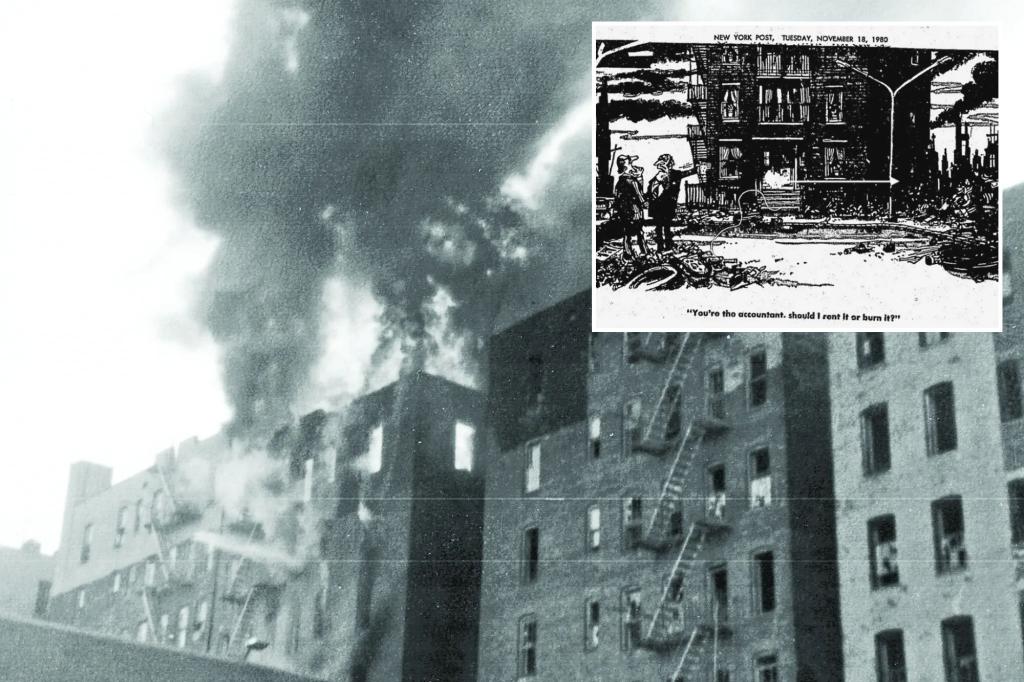In the early hours of an April morning in 1975, New York landlord Imre Oberlander and his associate, Yishai Webber, donned disguises — wigs and blackface — and set out in their car from Williamsburg, Brooklyn.
They planned to burn down one of the six buildings Oberlander owned, but their illicit efforts were thwarted when a police officer pulled them over for a broken taillight, only to find firebombs in their car. Both men were promptly arrested.
“Oberlander became one of the first landlords charged in connection with the decade’s epidemic of arson,” writes historian Bench Ansfield in “Born in Flames: The Business of Arson and the Remaking of the American City” (W.W. Norton, Aug. 19).

The book disputes the long-held notion that tenants were responsible for many of the notorious fires that burned in New York City in the ’70s and ’80s, many of them in The Bronx. Instead, Ansfield places the blame on flawed and inadequate legislation and greedy landlords.
After the protests and civil unrest in 1960s Gotham, many smaller landlords had cut their losses in areas like The Bronx to seek new opportunities in the suburbs, leaving large amounts of cheap property waiting to be snapped up.
Eager to breathe life back into the area, a new federal and state initiative, the Fair Access to Insurance Requirements (FAIR), was launched in 1968 to encourage new investment by providing a state-backed safety net for property owners who could not obtain insurance in the standard market.
The policy aimed to rectify inequalities, but Ansfield exposes how the policy instead deepened them, leading to widespread displacement and housing insecurity that continues to shape urban landscapes today.
FAIR was fundamentally flawed. While it ensured new owners and tenants could get state-backed insurance for properties, it valued buildings at much higher sums than their actual market value, leading to corrupt landlords exploiting the policy.
That was what happened with the building at 1895 Belmont Ave.

The bank valued it at just $5,000, but it was covered for $250,000 by insurance. Inevitably, it was targeted by its unscrupulous landlord.
On Aug. 29, 1976, Carmine Lanni, the owner of the building and a landlord who specialized in buying run-down buildings, hired handyman Popo Vega to torch the place.
That night, Vega hauled a five-gallon container of gasoline up to a vacant apartment on the fifth floor, dousing the unit with the fuel. When he tried to ignite it, the build-up of fumes resulted in a huge explosion instead.
Vega escaped, and, remarkably, nobody died. But some of the 17 families living in the building witnessed him doing it and reported him to the police.
Soon after, Vega was arrested. He accepted a reduced sentence on the condition that he wear a wire when he next met with Lanni.

It wasn’t long before Lanni had another job for Vega, asking him to burn down 2025 Valentine Ave., a building he had bought for just $7,000 but was now worth $100,000 if the insurance paid out.
When police heard the conversation, Lanni was arrested and sentenced to 15 years in prison. Evidence also revealed that Lanni was one of six landlords who ran an arson-for-hire business out of a Bronx storefront directly responsible for 17 fires in the area.
Landlords, keen to insulate themselves from prosecution, routinely sought out young men or boys of color who lived near the buildings to do their dirty work, paying them to carry out the attacks. “It was exceedingly difficult to incriminate anyone but the person who struck the match,” adds Ansfield.

The trend also had the effect of deepening the impoverishment in The Bronx. “To be a young person in The Bronx was to be shut off from most socially sanctioned means of earning money,” says Ansfield. “For the young torches who made up the rank and file of the arson industry, the money they could scrape together burning buildings was a significant enticement.”
That, argues Ansfield, is the real reason black and brown tenants were blamed for the arson wave, not just in New York but across the country.
“All these decades later, the vague impression that Bronxites burned down their own borough endures,” he writes. “Yet the evidence is unequivocal: the hand that torched The Bronx and scores of other cities was that of a landlord impelled by the market and guided by the state.”

More worrying, argues Ansfield, is that the inequality that fueled the fires in the 1970s hasn’t gone away.
“The wave of landlord arson has receded,” he says. “Yet its source — the lethal alchemy of race and capitalism — endures.”
The post Greedy landlords — not Bronx residents — were really to blame for the fires that ravaged NYC in the ’70s and ’80s: new book appeared first on New York Post.




